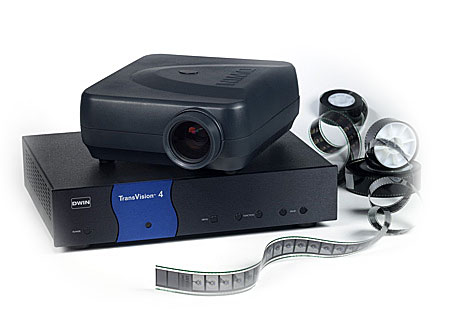DWIN TransVision 4 DLP Projection System

You Two-Timer You
Back in the day, there were only a few choices in video processing to bring out the best in your CRT projector. DWIN became known as the little guy that offered as much as Faroudja for half the price (just ask the lawyers.) The more things change, the more they stay the same. DWIN's original "TranScanner" was a device that would switch, scale and "transcode" all your video sources. All that poured out of the TranScanner was a single (but pretty fat) run of RGBHV cables that was then snaked through the ceiling or floor until it hit the projector. The TransVision 4 has its own TranScanner of sorts, this one even more capable than the one I'm using with the CRT.
As for inputs, there are (two each) composite, component and S-Video, same as my original TranScanner. Instead of a single RGB pass-through, the new box has two RGB inputs. But the pièce de résistance are the dual HDCP-compatible DVI inputs making the new model a switcher for the 21st century. The rear panel also has dual 12-volt DC triggers for signaling a motorized screen. I guess I shouldn't be surprised that a company owned by Armenians would put two of everything in their processor. After all, Noah's Ark landed on Mt. Ararat, which every Armenian proudly acknowledges belongs to Armenia, and Noah was the king of twos!
Like the more than twice as expensive SIM2 HT300 E-LINK, the DWIN's video processor transcodes and converts all input sources to the 1280x720 native resolution of the projector itself. Both the SIM2 and the DWIN use a single cable to carry the signal from the processor to the projector, though that cable is different. DWIN uses a DVI connection that's terminated with a special round connector at the projector end to simplify routing the cable through walls. SIM2 uses three diminutive optical cables bundled in a single sheath smaller than your pinky for an even easier installation that's good over long distances.

The front panel of the video processor is Spartan by design. The left side holds a single flush mounted standby switch below a small, non-distracting green LED that blinks when the processor is in standby and remains solid when driving the projector. Over on the right side, five more flush mounted buttons activate and navigate the system menu.
DWIN includes a very nice multi-function remote, which can be used to control up to seven other devices. It's neither too heavy nor too light, and its shiny metallic top is countered by a comfortable, rubberized backside. A side-mounted pad activates backlighting for all the buttons and the small LCD display area. There's even a separate manual for it so you can program your life away. While I'm not really into futzing much with programmable remotes, this one looks easy enough to set up.
The DWIN suffers from the same non-fatal flaw as the InFocus Screenplay 7210 – no vertical lens shift. Those of you upgrading from CRTs wouldn't know any better, but a vertical lens shift sure makes life easy during installation. Content yourself with the knowledge that, through the miracle of modern science, projectors no longer weigh as much as a grown man after a lobster buffet. The TransVision 4 has a fixed vertical and horizontal offsets enumerated in the user manual, so you or your dealer can easily calculate where the projector has to be vertically in relation to the bottom of the screen (or top if you're installing this on the ceiling). Since this was not a permanent installation, the review sample ended up on the lamp table next to my viewing chair, atop a stack of coffee table books, which hitherto had served no useful purpose.




























































